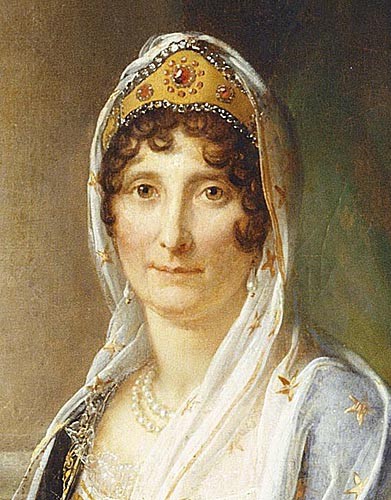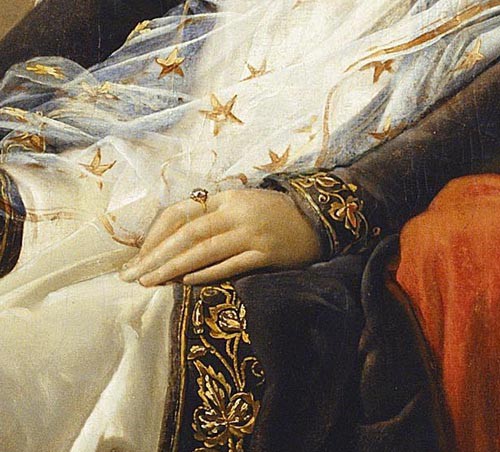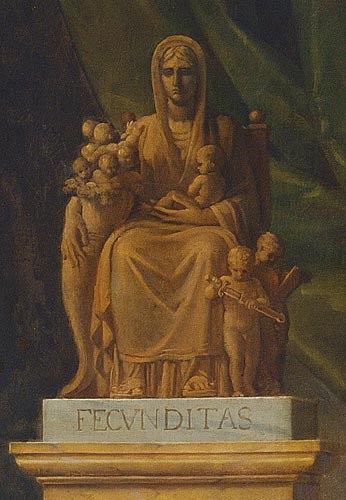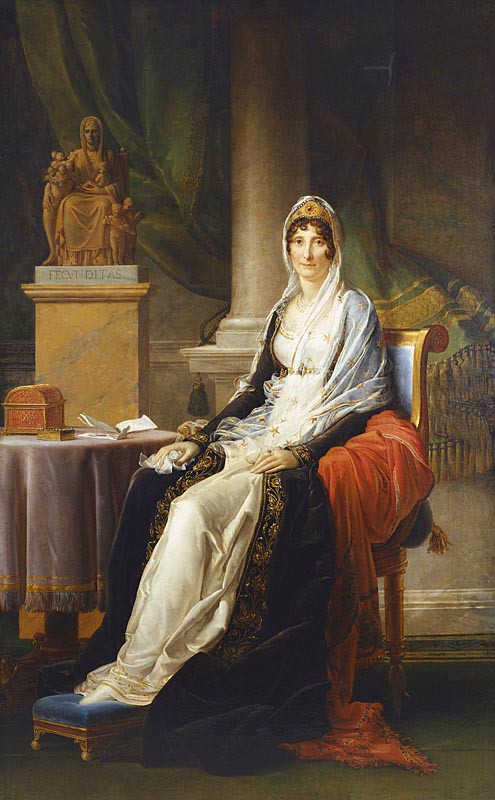Madame Mère
Of the portraits painted by the Baron Gérard of Madame Mère, this canvas is the first and perhaps the most personal and freely painted. It is the very much the image of a mater familias, and has remained with her family until the present day.
Napoleon's mother, Maria-Letizia Ramolino, was born on August 24, 1749 or 1750 in Corsica, then part of the Republic of Genoa. She descended from a reputable Tuscan family which had established itself in Corsica several generations earlier. In 1764, she married the young and handsome Carlo-Maria Buonaparte (1746-1785) who was then studying law. Together, they had thirteen children, eight of whom survived (five boys: Joseph, Napoleon, Lucien, Louis and Jerome; and three girls: Elisa, Pauline and Caroline). In the early years of their marriage, political complications took their toll on the young couple's life, in particular the acquisition of Corsica by France in 1768, just months before Napoleon's birth. The family was also in a very precarious financial situation during this period, and when her husband died in 1785, Letizia struggled with enormous economic difficulties.
The onset of the French Revolution in the summer of 1789 triggered a resurgence of political unrest in Corsica. In 1793, Letizia and her younger children had to flee the island and find refuge in mainland France, first in Toulon and later in Marseille, because Letizia and her elder sons refused to take part in the uprising against French authority. The family's financial situation began to improve only when Letizia's second son, Napoleon, began his spectacular rise through the ranks of the Republican army. When Napoleon was named Field Marshall of Domestic Armies in October 1795, he was able to provide for his family, who greatly needed the assistance.
 After the coup of November 9, 1799 against the Directoire government which placed Napoleon at the head of the French government, Letizia and her family enjoyed great material comfort. Napoleon granted his mother a number of generous pensions, and she moved into a luxurious mansion in Paris. Nonetheless, in spite of her son's rapid rise to fame and power and the ensuing privileges she enjoyed, Letizia remained very level-headed and never feared to express her views to her son, even if they differed from his. For example, when Napoleon and his brother Lucien disagreed regarding the latter's marriage, she sided with Lucien and refused to attend Napoleon and Josephine's coronation on December 2, 1804. One should also keep in mind that she never truly approved of Josephine or her family, whom she found to have too heavy an influence on her son. Despite her absence on the occasion of Napoleon and Josephine's crowning, the Emperor asked Jacques-Louis David to feature his mother prominently in his large scale composition commemorating the event (Musée du Louvre, Paris, fig. 1).
After the coup of November 9, 1799 against the Directoire government which placed Napoleon at the head of the French government, Letizia and her family enjoyed great material comfort. Napoleon granted his mother a number of generous pensions, and she moved into a luxurious mansion in Paris. Nonetheless, in spite of her son's rapid rise to fame and power and the ensuing privileges she enjoyed, Letizia remained very level-headed and never feared to express her views to her son, even if they differed from his. For example, when Napoleon and his brother Lucien disagreed regarding the latter's marriage, she sided with Lucien and refused to attend Napoleon and Josephine's coronation on December 2, 1804. One should also keep in mind that she never truly approved of Josephine or her family, whom she found to have too heavy an influence on her son. Despite her absence on the occasion of Napoleon and Josephine's crowning, the Emperor asked Jacques-Louis David to feature his mother prominently in his large scale composition commemorating the event (Musée du Louvre, Paris, fig. 1).
As Emperor, Napoleon bestowed on his mother the title of “Son Altesse Impériale, Madame Mère de l'Empereur” (Her Imperial Highness, Mother of the Emperor). He also gave her an annual pension of 300,000 francs, and a house with full staff, including a priest, ladies in waiting and servants. In June 1805, Napoleon bought the sumptuous Château de Pont-sur-Seine for his mother, which she adored, spending long periods of time in the Aube region where the castle is located. In spite of all these privileges, Letizia seems to have always sought to live quietly and save everything she could. One might venture to guess that she was aware of the possibility of another turn of fortune, and wanted to be prepared. It seems that she was skeptical of the durability of the Empire, which she expressed in a phrase which has since become famous: Pourvu que ça dure! (Let us hope it will last!)
 Her perspicacity was to serve her well. After 1814, as the downward spiral of defeats and disappointments had been set in motion, Madame Mère bravely and unwaveringly stood by her son. The former Emperor later remembered her solidarity and paid his mother homage in his conversations with Emmanuel, Comte de Las Cases during his exile at Sainte Hélène: “Cette même femme à laquelle on eût difficilement arraché un écu m'eût tout donné pour mon retour de l'île d'Elbe, et après Waterloo elle m'eût remis entre les mains tout ce qu'elle possédait… [The very woman from whom it would have been difficult to pry a coin would have given me everything for my return from the Island of Elba, and after Waterloo, she would have placed all her possessions in my hands].”
Her perspicacity was to serve her well. After 1814, as the downward spiral of defeats and disappointments had been set in motion, Madame Mère bravely and unwaveringly stood by her son. The former Emperor later remembered her solidarity and paid his mother homage in his conversations with Emmanuel, Comte de Las Cases during his exile at Sainte Hélène: “Cette même femme à laquelle on eût difficilement arraché un écu m'eût tout donné pour mon retour de l'île d'Elbe, et après Waterloo elle m'eût remis entre les mains tout ce qu'elle possédait… [The very woman from whom it would have been difficult to pry a coin would have given me everything for my return from the Island of Elba, and after Waterloo, she would have placed all her possessions in my hands].”
Madame Mère endured her changing fortunes without so much as a complaint. In 1814, she went to Rome to live in exile with her half brother, Cardinal Fesch. There, Pope Pius VII offered her shelter until she was able to join Napoleon on Elba. After his escape and return to Paris, Letizia managed to follow him to Paris, where she heard the news of the defeat at Waterloo, and the final fall of the Empire. After this, she traveled back to Rome, from where she unsuccessfully attempted to rejoin her son in Sainte Hélène, where he was held prisoner. After the news of her son's death reached her in July 1821, Letizia remained prostrate for weeks. She never left Rome again, continuing to live at the Palazzo Rinuccini, where she died on 2 February 1836, surrounded by her family which had always been what mattered most to her. Letizia was first buried in Italy, but in 1851, her grandson, who was soon to become Emperor Napoleon III, ordered that her remains be transferred to Ajaccio in Corsica.
The history of the painting
 When he was First Consul, Napoleon commissioned Gérard to paint a large scale portrait of his mother. Gérard was working on this composition when Johann Friedrich Reichardt, Frederick the Great's onetime Kapellmeister, visited him in his studio in the last months of 1802 (see A. Laquiante, Un Hiver à Paris sous le Consulat d'après les lettres de J.F. Reichardt, Paris 1896, p.216).
When he was First Consul, Napoleon commissioned Gérard to paint a large scale portrait of his mother. Gérard was working on this composition when Johann Friedrich Reichardt, Frederick the Great's onetime Kapellmeister, visited him in his studio in the last months of 1802 (see A. Laquiante, Un Hiver à Paris sous le Consulat d'après les lettres de J.F. Reichardt, Paris 1896, p.216).
There are three different compositional versions of Gérard's portrait of Madame Mère, and the variations among these faithfully reflect Napoleon's rapidly evolving political status. These include the present painting, another composition with significant differences is now in the National Gallery of Scotland, Edinburgh (see fig. 2) and the third variation is best represented by the canvas at Versailles (see fig.3).
The present painting displays the sitter seated next to a statue of a motherwoman surrounded by her children, placed on a base which is inscribed FECUNDITAS [Latin: Fertility]. This portrait is very faithful to Letizia's true appearance: she was a very elegant and dignified woman, whose features could be called classical in that they recall a lady of ancient Rome's patrician class. Clad in a white satin gown and a deep violet with gold details, Madame Mère sits by a table covered in a lilac colored rug, and on which lays a small chest, a sweet box and an unfolded letter. Behind the sitter, a column alongside which falls a heavily embroidered green curtain closes off the composition. The richness of the fabrics of her attire and interior speak to the high position of Madame Mère, while the sobriety and balance of the composition indicate the virtue and restraint that characterized Letizia's life. Gérard chose to place his sitter towards the right of the composition, which is balanced by Letizia's leftward angle as she turns slightly in direction of statue in the background. The meaning and intention of the painting are clear: to pay homage to the woman who bore the many and glorious Bonaparte children.
Although Reichardt did not describe in detail the portrait that he saw in Gérard's studio, it is extremely likely that it was the present picture; this painting must have been painted prior to Gérard's other known aforementioned portraits of the sitter. Indeed, this painting pays homage to Madame Mère herself and her role as matriarch, whereas subsequent versions replace the statue of Fertility with Napoleon's bust, shifting the tenor of the pictures from a family portrait to an indirect glorification of the Emperor himself. Moreover, the pictorial quality and the beauty and finesse with which the fabrics are rendered indicate that the picture is most probably fully by Gérard's hand. Moreover, the painter and his studio would not have had enough time to execute an exact replica of this composition before it was modified by the inclusion of the Emperor's bust (certainly by Napoléon himself), thus it remains the only known version of its type.
In the Edinburgh version (see fig 2), which was also painted during the Consulate, the bust of Bonaparte as First Consul (painted after Boizot's sculpted rendition) on the right side of the composition is the true focus of the picture. The painter chose to flip the composition, placing his sitter on the left of the central axis, who seems to present the viewer with the bust as she rotates slightly towards the right. Beyond the bust, one can see a glimpse of the Tuileries garden and palace. In the lower left corner, is the central motif of the carpet, which is reminiscent of a rose window. That version was in the collection of her son Jerome Bonaparte, passing with the Princesse Mathilde into the Demidoff family.
The third version, which is perhaps the most familiar one, is chronologically the latest. It was painted at the beginning of the Imperial era and is closely related to the preceding composition. However, the bust was again changed, from that of First Consul to that of Emperor crowned with a laurel wreath in the Roman manner (inspired by Chaudet's sculpture). Several replicas of this composition were painted to be given to various members of the Imperial family. One of these, painted for Louis Bonaparte, King of Holland, is currently preserved in the Musée National du Chateau de Versailles (fig. 3), while another is on view at the Musée Fesch in Ajaccio, and yet another at the National Museum of the Château of Fontainebleau.
In Malmaison is a version, almost square in format and differing in details of expression and the sitter's coiffure. It hung as early as June 1805 in Empress Josephine's large sitting room at St Cloud. It was then sent to the Gobelins factory to serve as cartoon for a tapestry, which was given to Catherine de Wurttemberg in 1812. The tapestry is currently preserved at the Château de Prangins, Switzerland. The small replica of the Portrait de Madame Mère that remained in Gérard's atelier until his death, now also in Versailles, is very close to that version.
Unlike her half brother Cardinal Fesch, who was an active and avid collector (see this sale, Part II, lot 273), Madame Mère had little interest in art. Nonetheless, she commissioned a number of artists for portraits, including Antonio Canova who sculpted a large marble portrait of her in 1804. This sculpture was inspired by the statue of Agrippina on the Roman Capitol, and effectively evokes a great lady of Ancient Rome. When it was shown at the Paris Salon in 1808, the famed architect Charles Percier expressed his great admiration for Canova's sculpture. Letizia gave it to her son Napoleon so that he might find a suitable place in the Tuileries, an offer he declined. It is now preserved in the collection of the Duke of Devonshire, Chatsworth (see fig. 4). Another noteworthy artist is Robert Lefèvre, who painted a full length portrait of Letizia Bonaparte in courtly attire, dated 1813. There are two versions of this picture, one of which is in Versailles, while the second is preserved in the Museo Napoleonico, Rome. Also, a few miniaturists worked for her, among whom François-Joseph-Juste Sieurac, who exhibited a small scale depiction of Madame Mère at the Salon of 1812, and the sculptor Charles Dupaty who presented a Bust of Madame Mère at the same Salon. This marble carving, which displays its model clad in classical drapery and crowned with a thick laurel wreath, is now on display in Fontainebleau.
The technical details
François-Pascal-Simon, called Baron Gérard (1770-1837)
PORTRAIT OF MADAME MÈRE, NAPOLEON 1ST'S MOTHER
oil on canvas
210 x 129cm
PROVENANCE
Probably offered by the sitter to her daughter Caroline Murat, Queen of Naples 1808-1815;
Collection of Princes Murat;
Collection of Prince Lucien Murat in 1913.
The painting was exhibited on loan for many years in the musée de l'Armée, Paris.
EXHIBITED
David et ses élèves, Palais des Beaux Arts de la ville de Paris, April-June 1913, n°125
Napoléon, Paris, Grand Palais, June-December 1969, n°478.
LITERATURE
Possibly Lettres adressées au Baron Gérard par les artistes et les personnages célèbres de son temps, second edition published by his nephew the Baron Gérard, Paris 1886, vol. II. (one of the portraits of Madame Mère listed in the list of paintings painted by Gérard);
Catalogue of the exhibition Cinq années d'enrichissement du patrimoine national 1975-1980, Galeries nationales du Grand Palais, Paris, 15 November 1980 – 2 March 1981, mentioned page 148 under n°124 ;
G. Lacourt-Gayet, Napoléon, sa vie, son temps, Paris 1921, plate p. 264 ;
Napoléon, Collection Génies et Réalités, Paris 1961, p. 140.
Will be included in the Catalogue Raisonné in preparation by Mr Alain Latreille.
Sale on Thursday, January 26th, Sotheby's New York
Enquiries:
New York: George Wachter – tel: +1 212 606 7230
Paris: Pascale Pavageau – tel: +33 1 53 05 53 10
Estimate : $ 700.000 – $ 1.000.000


